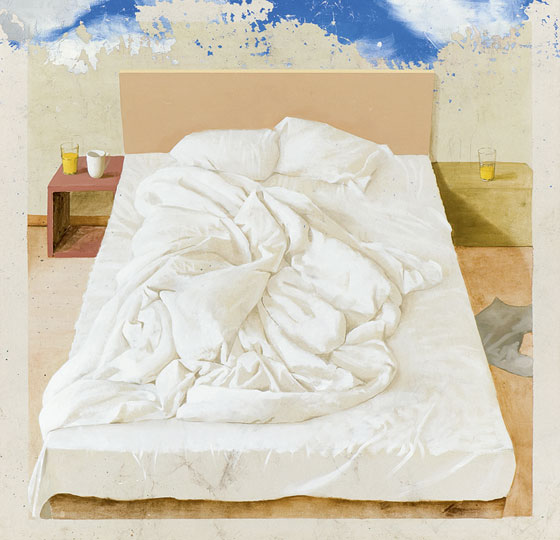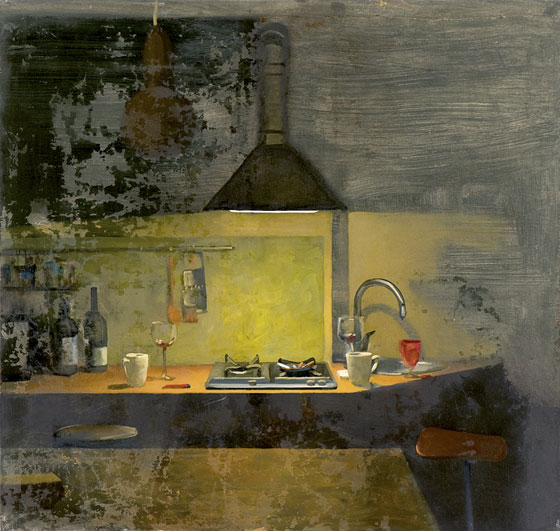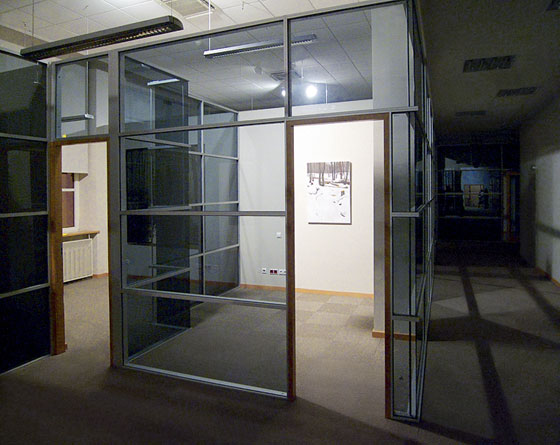|
|
| Present-day humanist Sniedze Sofija Kāle, Art Historian Andris Eglītis. Living Conditions 25.11.–18.12.2010. In the former bank premises at 15 Kaļķu iela | |
| From November 25 to December 18, painter Andris Eglītis’ solo exhibition Living Conditions, organised with the support of Art Gallery 21, was open for viewing at 15 Kaļķu Street. For some years now, the solo exhibitions of this young artist have been eagerly anticipated in artistic circles. The body of the artist’s creative work so far confirms that Eglītis is an inveterate realist and one might not expect anything “new” from him. How then to explain the expressive power of his paintings? | |
 Andris Eglītis. 10.05.2010. Oil on canvas. 185x192 cm. 2010. Courtesy of the artist | |
| The debatable position of realism most clearly revealed itself in the 20th century, when photography won its right to the status of ‘art’, proving that the lens of the camera in a photographer’s hands is equal to the paint brush in the hand of an artist. If we examine the notion of realism in a broader perspective, then it is possible to explain by the tradition of mimesis in art, which is opposite to the abstract approach. The overall development of art, moving away from flat religious paintings and embracing the depiction of the profane, despite the variety of styles has preserved the interaction between the real and the abstract throughout the centuries. It must be noted that the state of “comprehensive realism” can at times seem to discredit itself, if certain of its modifications were to be evaluated according to the principles of truthfulness. For example, when the quick-witted ideologists of Soviet Russia were implementing Social Realism back in 1936, they realized that it is possible to use mimesis in works of art to construct and keep “alive” the benefits of a future Socialist paradise. Likewise, a few decades later the visual language perfected by the Photorealists – the objective fixation of the world with utmost correspondence to reality – manifested itself as a direct reproduction of places and things, where commonplace objects gained an unprecedented (as if false) and permanent presence in our consciousness. On the other hand, when gazing at the reality depicted in the paintings of Andris Eglītis, one gets an impression of a humane world. Whether they be industrial areas or rural landscapes with a pronounced displacement of the horizon line (Painting No. 18 and Painting No. 12), portraits of his contemporaries (Marta), or the lonely floors of new high-rise block buildings in a laconic space (paintings from the solo exhibition Under the Sky, nominated for the Purvītis Prize in Visual Arts in 2009), overgrown and abandoned railway stations (works from a 2009 solo exhibition I Want to Be There, currently nominated for the Purvītis Prize 2011), or insignificant everyday objects (exhibition The Order of Things) – throughout all these works one can discern an inner measuring up of the human aspect with its surroundings. The painter’s choice of subject matter – prosaic daily life – is modest and unpretentious, and it does not require the viewer to have any special preparation except life experience and sensitivity to new insights. In the overall context of contemporary art in Latvia, Andris Eglītis’ paintings stand out as the most democratic, because he uses classical media (which is “considered as art” in society at large) and a recognizable “contents”. | |
 Andris Eglītis. 22.04.2010. Oil on canvas. 128x137 cm. 2010. Courtesy of the artist | |
| Despite the artist’s sceptical attitude towards explaining his work, he has on one occasion written about himself: “Paintings as studies and not as affirmations of one’s abilities; striving for an ideal world or a quest for truth or the desire to test the possibilities of suggestive, overwhelming and spine-tingling art are the current motives in Bioethanol’s (Andris Eglītis – S.S.K.) creative work.”1 The conscious efforts to include an “ideal world” into the painted reality draw viewers in, and hold their unwavering interest in Eglītis’ creative work. In his latest solo show Eglītis continues the depiction of reality, as started before, albeit in a slightly different way. Living Conditions is a collection of comparatively autonomous paintings which can be comfortably united under such an all-embracing title. Hung in the middle of each abandoned room of the office building there is the one painting – a window through which the viewer can sense the essence lying behind the reality that has been reproduced in the paintings. Art critic Ieva Kulakova has concisely formulated this idea in the exhibition catalogue: “At times in life things happen the other way round. To lead someone to the essential, less should be said about the essential. Namely, to talk about the meaning of life or about ideals, one must talk about daily life, about what it consists of.”2 The painting 07.08.2010 stands out from the overall context of the exhibition, a kind of farewell to Andris Eglītis’ superb exhibition in the old storage building next to Cēsis Railway Station. All the other paintings are united by pure oil painting technique and a return to approaches used previously. The artist has sought to call attention to the framing of visible reality. Moments of life, intuitively picked out by the artist and strung along like diary entries, are like fragments of a mosaic that can never be finished. A similar approach can be perceived in the choice of the painting finishes – there are traces of drawings left (10.05.2010), unpainted parts of canvas (23.08.2010), missing details (25.10.2010) – all these factors vividly express incompleteness on the painting surfaces. On the other hand, paint smudges, dribbles and scratches (22.04.2010) seem to be picking a fight with the “perfect” depiction of reality, implying that one must search for the essential beyond sensory perception. Unlike other Eglītis’ solo exhibitions, the surfaces of the paintings contain unmistakeable references to the fact that what you see is not just unequivocal reality. This is conveyed by using incompleteness, “defects” and the framing of canvases. Could this be interpreted as the surrender of reality in the face of the absolute? | |
 View from Andris Eglītis' exhibition Living conditions. Courtesy of the artist | |
| There is an idea that is much more compelling, one that features in a legend about Riga: when the city is completed, it will immediately sink into the waters of the river Daugava and disappear into nothingness. Likewise, a painting which is not yet completed can offer much wider possibilities of interpretation, it still contains its as yet unexhausted creative beginnings. The light and thin brushstroke and gentle gradations of tone together with intentional incompleteness creates a feeling of the freedom of choice (23.08.2010). It is as if Andris Eglītis has succeeded in stopping time, which is now being observed by someone holding their breath in positive expectation. Here one does not have to hurry to make any existential decisions which may decide the course of tomorrow, here one simply has to give way to the magic of the moment (17.04.2010). Completely different emotions overpower the viewer when looking at the works in which artificial lighting dominates. In this stifling environment the people, too, look unwell (10.02.2010), worn-out and exhausted (12.01.2010). The cosily designed room (08.03.2010) and even nature (22.09.2010) as if shrivel in the light of the lamps and become inaccessible. Andris Eglītis’ unobtrusive seriousness (which in contemporary art could be considered slightly daring) pulls the viewer into the painted reality, unleashing living feelings. Each painted canvas on its own conjures up an autonomous world in which a seemingly non-essential fragmentation of reality can be remarkably multi-faceted, affecting and deep as the lifetime of a human being. Notwithstanding the intentional imperfections of form, the paintings reveal conditions where one can find “true” and powerfully impressive witness to the presence of a live human being. /Translator into English: Vita Limanoviča/ 1 www.makslaxogalerija.lv/eng/artists/andris-eglitis-2 2 Kulakova I. Ar galvu pie zemes, ar kājām – debesīs. // Living Conditions. Catalogue of Andris Eglītis’ solo exhibition. – Art Gallery 21. 2010 | |
| go back | |







